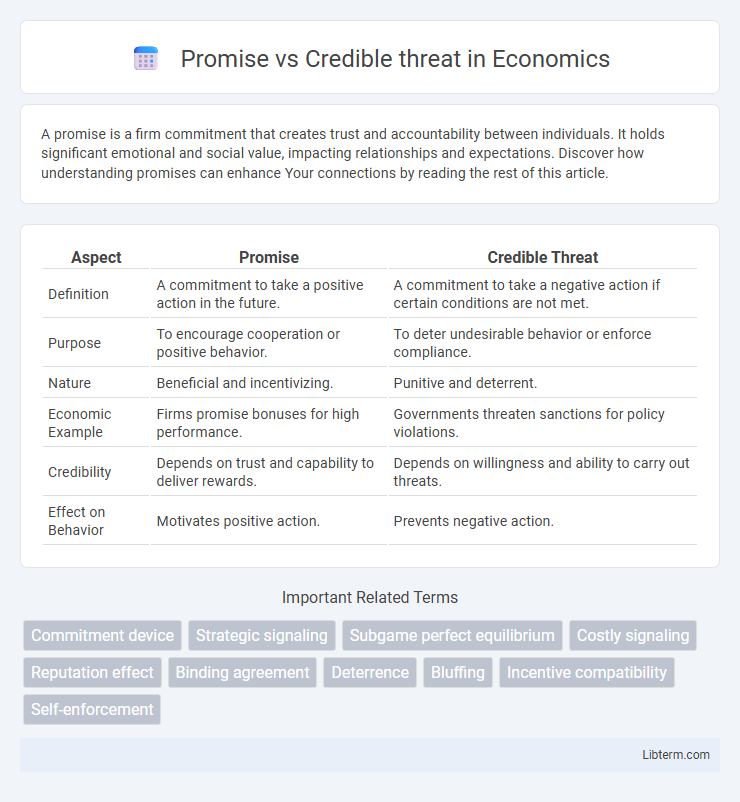A promise is a firm commitment that creates trust and accountability between individuals. It holds significant emotional and social value, impacting relationships and expectations. Discover how understanding promises can enhance Your connections by reading the rest of this article.
Table of Comparison
| Aspect | Promise | Credible Threat |
|---|---|---|
| Definition | A commitment to take a positive action in the future. | A commitment to take a negative action if certain conditions are not met. |
| Purpose | To encourage cooperation or positive behavior. | To deter undesirable behavior or enforce compliance. |
| Nature | Beneficial and incentivizing. | Punitive and deterrent. |
| Economic Example | Firms promise bonuses for high performance. | Governments threaten sanctions for policy violations. |
| Credibility | Depends on trust and capability to deliver rewards. | Depends on willingness and ability to carry out threats. |
| Effect on Behavior | Motivates positive action. | Prevents negative action. |
Understanding Promises and Credible Threats
Promises and credible threats are strategic tools in negotiation and game theory, where promises involve committing to a positive action if certain conditions are met, enhancing trust and cooperation. Credible threats, by contrast, hinge on the ability and willingness to enforce a negative consequence, deterring undesirable behavior through perceived reliability. Understanding the difference between these concepts is essential for predicting behavior and formulating effective strategies in competitive and cooperative interactions.
Defining the Core Differences
Promises involve commitments to take or refrain from certain actions contingent on another party's behavior, creating positive incentives for cooperation. Credible threats entail assertive warnings to impose costs or punishments if specific actions are taken, enhancing deterrence effectiveness. The core difference lies in promises fostering trust through anticipated rewards, whereas credible threats rely on the believable potential of sanctions to influence behavior.
Psychological Impact on Stakeholders
Promises foster trust and positive expectations among stakeholders by signaling commitment and reliability, which enhances cooperation and reduces uncertainty. Credible threats generate fear and anxiety, often leading to defensive behaviors, risk aversion, and potential conflicts within stakeholder relationships. The psychological impact of promises encourages engagement and long-term collaboration, whereas credible threats may undermine trust and create a climate of tension.
Role in Negotiation Strategies
Promises in negotiation strategies serve as commitments to future actions that build trust and facilitate cooperative outcomes, enhancing the likelihood of reaching mutually beneficial agreements. Credible threats function as strategic tools to influence the opponent's decisions by signaling potential negative consequences, thereby deterring undesirable actions and shifting bargaining power. Effective negotiators leverage promises to establish cooperation while using credible threats to maintain leverage and enforce agreements.
Real-World Examples: Promise vs Credible Threat
North Korea's promise to denuclearize in exchange for sanctions relief contrasts sharply with its credible threat of missile testing, which has repeatedly shifted international negotiations. In 2014, Russia's promise to respect Ukraine's sovereignty clashed with its credible threat and subsequent annexation of Crimea, destabilizing the region. The US government's credible threat of military intervention in Syria has often outweighed diplomatic promises, influencing rebel group behaviors on the ground.
Effectiveness in Conflict Resolution
Promises enhance trust by creating positive expectations, fostering cooperation in conflict resolution through commitment to actions. Credible threats rely on perceived consequences to deter undesirable behavior, often compelling opponents to comply to avoid negative outcomes. Effectiveness depends on the clarity and reliability of the signals, where promises build long-term collaboration while threats yield immediate compliance but may damage relationships.
Risks and Consequences Involved
Promises establish expectations with potential positive outcomes but carry the risk of credibility loss if unfulfilled, damaging trust and future cooperation. Credible threats involve potential punishment or negative consequences, which can escalate conflicts or provoke retaliation, increasing instability and uncertainty. Both promises and credible threats influence strategic decision-making, yet miscalculation or misinterpretation may lead to unintended escalation or missed opportunities.
Ethical Considerations in Usage
Promises and credible threats carry distinct ethical implications in strategic communication and negotiation contexts. Promises, grounded in trust and mutual benefit, foster cooperation and long-term relationships by aligning actions with commitments, thereby supporting ethical standards of honesty and reliability. Credible threats, while sometimes necessary to enforce boundaries or deter harmful actions, risk ethical concerns if perceived as coercive, manipulative, or disproportionate, potentially undermining trust and creating adversarial dynamics.
Assessing Reliability and Feasibility
Assessing the reliability of a promise involves examining past behavior, consistency, and the incentives aligning with keeping the commitment, which ensures trustworthiness. In contrast, evaluating the feasibility of a credible threat requires analyzing the capability, resources, and potential consequences that make carrying out the threat realistic and convincing. Both reliability and feasibility are crucial in strategic decision-making, affecting how stakeholders perceive and respond to promises or threats.
Choosing the Right Approach for Desired Outcomes
Choosing between a promise and a credible threat hinges on the desired behavioral outcome and relational context. Promises effectively motivate cooperation and trust by signaling positive reciprocity and mutual benefit, often leading to sustainable, long-term engagement. Credible threats, based on the ability to impose costs or consequences, are suited for deterring undesirable actions but risk escalating conflict or damaging relationships if overused or perceived as insincere.
Promise Infographic

 libterm.com
libterm.com